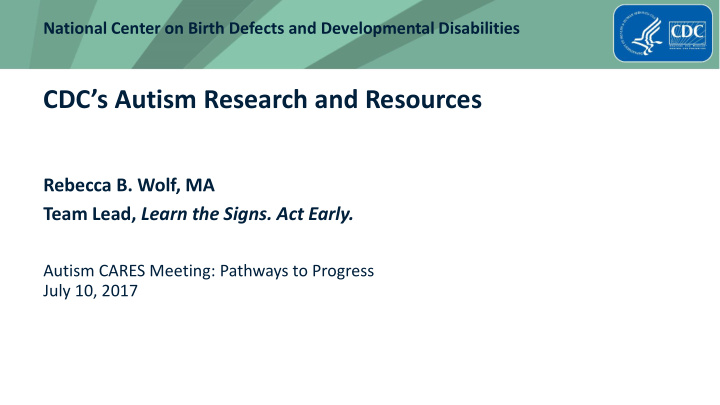



National Center on Birth Defects and Developmental Disabilities CDC’s Autism Research and Resources Rebecca B. Wolf, MA Team Lead, Learn the Signs. Act Early. Autism CARES Meeting: Pathways to Progress July 10, 2017
Autism Research: SEED and ADDM
Study to Explore Early Development (SEED) ▪ Case-control study of children aged 2.5 – 5 years in 6 states ▪ Describe phenotypic variability among children with ASD ▪ Evaluate etiologic risk factors for ASD, e.g., • Role of infection & immune function • Role of specific obstetric complications (preterm delivery, C-section, assisted reproductive technology) • How phenotypic variability is associated with genetic or environmental risk factors
Autism & Developmental Disabilities Monitoring Network (ADDM) ▪ Medical, school record review ▪ 8-year-olds – 10 sites ▪ 4-year-olds – 6 sites ▪ Not a national estimate ▪ Shows trends over time ▪ Next report: Spring 2018 for surveillance year 2014 ▪ DSM-IV-TR vs DSM-5 comparison
Autism Resources: Learn the Signs. Act Early.
Learn the Signs. Act Early. To improve early identification of developmental delays and disabilities, including autism, by promoting developmental monitoring and screening so children and their families can get the services and support they need.
Three Components: Health Education ▪ - To help families “learn the signs” of healthy development and understand when and how to “act early” Act Early Initiatives ▪ - To improve communication and coordination among systems that must work together to identify and care for children with disabilities Research and Evaluation ▪ - To refine our efforts and identify promising practices for improving early identification
Learn the Signs. Act Early. Free Resources
For Everyone: Milestone Checklists
For Everyone: CDC Milestone Tracker App
For Everyone: Illustrated Milestones
For Parents: Children’s Books
For Providers: Training Developmental milestones & monitoring, Identifying, diagnosing, and w hat to do if there’s a concern managing autism spectrum disorder
Learn the Signs. Act Early. Partnerships for Implementation
▪ Work with programs that serve young families to integrate developmental monitoring ▪ Provide high-quality, research-based resources for providers and families ▪ Developmental monitoring complements developmental screening
Act Early Ambassadors 45 Ambassadors in 44 ▪ states/territories Community champions to ▪ improve early identification practices Serve as state or territory point-of-contact for the national program ▪ ▪ www.cdc.gov/ncbddd/actearly/ambassadors-list.html
Making the Case for Programs and Providers
Learn the Signs. Act Early. Promising Practices ▪ Locally inspired models and ideas ▪ Selection criteria: reach, acceptability, sustainability, generalizability, evaluation results https://blogs.cdc.gov/actearlypromising practices/
For Learn the Signs. Act Early: For ADDM, SEED: Becky Wolf Phyllis Nichols rwolf@cdc.gov ppm8@cdc.gov ActEarly@cdc.gov www.cdc.gov/Autism www.cdc.gov/ActEarly For more information, contact CDC 1-800-CDC-INFO (232-4636) TTY: 1-888-232-6348 www.cdc.gov The findings and conclusions in this report are those of the authors and do not necessarily represent the official position of the Centers for Disease Control and Prevention.
Helpful Links ▪ www.cdc.gov/milestonetracker ▪ www.cdc.gov/milestonesinaction ▪ www.cdc.gov/watchmetraining ▪ www.cdc.gov/autismcasetraining ▪ https://blogs.cdc.gov/actearlypromisingpractices/ ▪ https://www.cdc.gov/ncbddd/autism/seed.html ▪ https://www.cdc.gov/ncbddd/autism/addm.html ▪ www.cdc.gov/autism
Recommend
More recommend